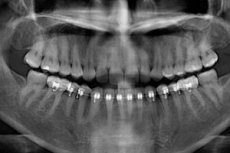Panoramic picture of the upper, lower jaw
Last reviewed: 23.04.2024

All iLive content is medically reviewed or fact checked to ensure as much factual accuracy as possible.
We have strict sourcing guidelines and only link to reputable media sites, academic research institutions and, whenever possible, medically peer reviewed studies. Note that the numbers in parentheses ([1], [2], etc.) are clickable links to these studies.
If you feel that any of our content is inaccurate, out-of-date, or otherwise questionable, please select it and press Ctrl + Enter.

Among the instrumental methods of examination in dentistry, dental orthopedics, as well as maxillofacial surgery, the most informative is a panoramic jaw. It is obtained either with the help of an overview radiograph (orthopantomography) or a more modern cone-beam computed tomography (dental CT), which makes it possible to obtain not only a 3d panoramic image of the jaw, but also the entire maxillofacial area of the skull.
Indications for the procedure
Examining the oral cavity visually, the dentist can see and evaluate only the condition of the tooth crowns, gingival pockets and tissues covering the gums. General information on the state of hard tissues and root canals of several teeth located side by side can be obtained with the help of close-focus intraoral radiography.
But if you take a panoramic shot of the jaw, the doctor gets an opportunity to visualize the entire dental system of the patient: dentin and dental pulp; dentogingival canals, alveolar processes and located in them dental roots; defects of the dentition, cortical plate and entire bone tissue of the jaws.
Indications for a panoramic image of the jaw - both lower and upper - affect endodontic treatment (treatment of the root canals) with advanced multiple caries, treatment of periodontitis, radical dental cysts or granulomas. Appoint such a diagnostic procedure and with improper teething wisdom, since retention and dystopia of third molars often require their removal.
In the dental orthopedics, a panoramic snapshot of the jaw allows to assess the condition of the dentoalveolar system and eliminate the defects of the dentition by the most suitable method of prosthetics (including implant placement), as well as to solve other problems (for example, polyodontia - the presence of extra teeth).
3d panorama of the jaw (in combination with 3d-cephalometry) is the basis for choosing the optimal method for correcting the occlusion by orthodontists (whether using brackets or more complex orthodontic devices).
The need to clarify local topographic features is due to the indications for a panoramic jaw picture in the maxillofacial surgery. In particular, these are inflammatory processes and bone injuries (fractures, contracture of the temporomandibular joints of the jaws, osteomyelitis or periostitis of the jaw) and soft tissues of the jaws (submandibular phlegmon, abscesses, neoplasms), and deformations of various etiologies.
In addition, in the panoramic image of the jaw obtained with cone-beam CT, inflammatory ENT pathologies associated with the maxillary and frontal sinuses are clearly visualized.
 [3]
[3]
Preparation
Preparing for a panoramic image of the jaw is unnecessary, except for the need to remove all metal jewelry and placing on the trunk of the lead protective apron. Orthopantogram is spent standing, dentoalveolar CT - sitting.
 [4]
[4]
Technique of the a panoramic jaw picture
Also, many clinics use Japanese equipment Morita (3DX Accuitomo) and devices of South Korean production (Vatech Co., Ltd) - Picasso-Pro and Picasso Trio 3D software & Digital Panoramic.
Who should I contact to get a panoramic shot of the jaw? You should contact a dental clinic or a medical institution with a dental department who have appropriate equipment. Typically, a patient is assigned a panoramic image of the lower jaw or a panoramic shot of the maxilla when visiting a dentist and identifying the problems that were described at the beginning of this publication.
Contraindications to the procedure
The main contraindications for a panoramic image of the jaw are pregnancy and the period of breastfeeding. If such a check is necessary for cancer patients after the advent of radiotherapy, it is recommended that the cone-beam computed tomography be more sparing for radiation doses.

